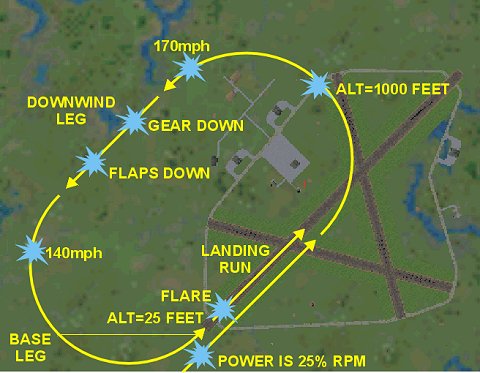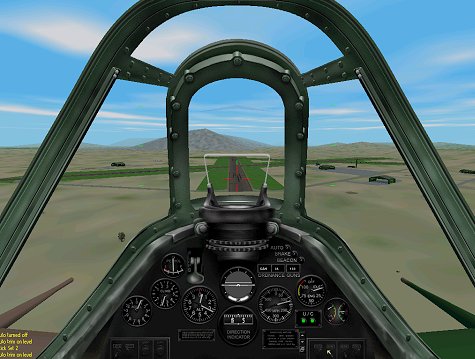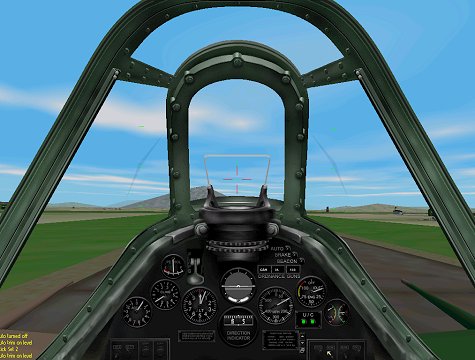Landing Lesson
Keyboard Controls
Engine start/stop: E
Throttle: Increase throttle [+] - Decrease throttle [-]
Rudder: Left rudder [A] - Center rudder [S] - Right rudder [D]
Brakes: SPACEBAR
Landing gear up/down: G
Flaps: Fully down [Q] - Fully up [W]
The Landing
1. Choose an aircraft and field from the Select menu. Ensure that you have enough fuel, take off, and fly
out a few miles. Don't go above 5,000 feet above ground level.
2. Around three to five miles out (you should be able to zoom the map to see how the runways line up, or
use your printed maps), turn and line up with the airfield.
3. Fly to the field - descending to 2,000 feet above ground level (AGL). The most important thing here is
to set up a good approach - if you're inexperienced, a bad approach will screw up your landing.
4. Reduce your power to about 25% and hold your altitude - your speed will start to bleed off.
5. Fly over the runway - at mid field with power off (or 25%), break turn 90 degrees to the left. You should
be down to 1000 AGL.
6. Fly out for about half a mile or a count of five, and then break left 90 degrees and enter a downwind
leg.
7. Drop your gear (the two 90 degree break turns at low power should have bled your speed down to a
reasonable gear speed). Abeam the numbers, drop some flaps. The flaps (in effect) alter the shape of the
wing and create more drag (to slow you down), and lift (to enable you to fly slower without stalling). When
you lower the flaps, the nose of your aircraft will drop slightly. Be ready to counter this with stick back, and
keep the aircraft in a gentle (500 feet per minute) descent.
8. Turn 90 degrees onto the base leg and continue your 500 fpm descent. Add more flaps. Look out the
left window and time your turn to final. Once you get a rhythm down, this will work as one fluid 270 degree
turn from entry to downwind all the way through, rolling out on final.
9. As you cross the runway threshold, you should be at about 50 feet and 100mph. All you need to do is
drop the aircraft gently onto the runway.
You do this by pulling back gently on the stick, which causes the aircraft to slow down and sink, and also
sets the aircraft in the correct attitude for landing. This is called flaring
If you are sinking too fast, add just enough power to arrest the sink rate, but do not begin a climb.
10. As the plane touches down, stop the engine, and start braking.
11. Steer the aircraft to a complete stop on the runway and exit the plane.
Landing in Practice
When you are flying online, many landings are not carried out as described in the procedure above. There
are various practical reasons for this, like running out of fuel, engine damage, landing under fire, or most
often, simply because you've cocked up the approach, and you're too eager to land and replane.
Most times this is when you've made the approach too fast, too high, or coming in at an angle to the runway.
These situations are things that you will learn in practice, but you'll be able to perfect some of these offline.
Once you've mastered the normal landing, practice coming in at an angle, or too fast or high. The controls
you'll find the most useful here are the flaps, throttle, and brakes.
Keyboard Controls
Engine start/stop: E
Throttle: Increase throttle [+] - Decrease throttle [-]
Rudder: Left rudder [A] - Center rudder [S] - Right rudder [D]
Brakes: SPACEBAR
Landing gear up/down: G
Flaps: Fully down [Q] - Fully up [W]
The Landing
1. Choose an aircraft and field from the Select menu. Ensure that you have enough fuel, take off, and fly
out a few miles. Don't go above 5,000 feet above ground level.
2. Around three to five miles out (you should be able to zoom the map to see how the runways line up, or
use your printed maps), turn and line up with the airfield.
3. Fly to the field - descending to 2,000 feet above ground level (AGL). The most important thing here is
to set up a good approach - if you're inexperienced, a bad approach will screw up your landing.
4. Reduce your power to about 25% and hold your altitude - your speed will start to bleed off.
5. Fly over the runway - at mid field with power off (or 25%), break turn 90 degrees to the left. You should
be down to 1000 AGL.
6. Fly out for about half a mile or a count of five, and then break left 90 degrees and enter a downwind
leg.
7. Drop your gear (the two 90 degree break turns at low power should have bled your speed down to a
reasonable gear speed). Abeam the numbers, drop some flaps. The flaps (in effect) alter the shape of the
wing and create more drag (to slow you down), and lift (to enable you to fly slower without stalling). When
you lower the flaps, the nose of your aircraft will drop slightly. Be ready to counter this with stick back, and
keep the aircraft in a gentle (500 feet per minute) descent.
8. Turn 90 degrees onto the base leg and continue your 500 fpm descent. Add more flaps. Look out the
left window and time your turn to final. Once you get a rhythm down, this will work as one fluid 270 degree
turn from entry to downwind all the way through, rolling out on final.
9. As you cross the runway threshold, you should be at about 50 feet and 100mph. All you need to do is
drop the aircraft gently onto the runway.
You do this by pulling back gently on the stick, which causes the aircraft to slow down and sink, and also
sets the aircraft in the correct attitude for landing. This is called flaring
If you are sinking too fast, add just enough power to arrest the sink rate, but do not begin a climb.
10. As the plane touches down, stop the engine, and start braking.
11. Steer the aircraft to a complete stop on the runway and exit the plane.
Landing in Practice
When you are flying online, many landings are not carried out as described in the procedure above. There
are various practical reasons for this, like running out of fuel, engine damage, landing under fire, or most
often, simply because you've cocked up the approach, and you're too eager to land and replane.
Most times this is when you've made the approach too fast, too high, or coming in at an angle to the runway.
These situations are things that you will learn in practice, but you'll be able to perfect some of these offline.
Once you've mastered the normal landing, practice coming in at an angle, or too fast or high. The controls
you'll find the most useful here are the flaps, throttle, and brakes.



Control your rate of descent with your THROTTLE, not with your elevators:
-Close the throttle to lose altitude, or increase your rate of descent.
-Open the throttle to gain altitude, or decrease your rate of descent.
Control your speed with your elevators:
-Pull back on the stick to slow down.
-Push forward on the stick to speed up.
-Close the throttle to lose altitude, or increase your rate of descent.
-Open the throttle to gain altitude, or decrease your rate of descent.
Control your speed with your elevators:
-Pull back on the stick to slow down.
-Push forward on the stick to speed up.